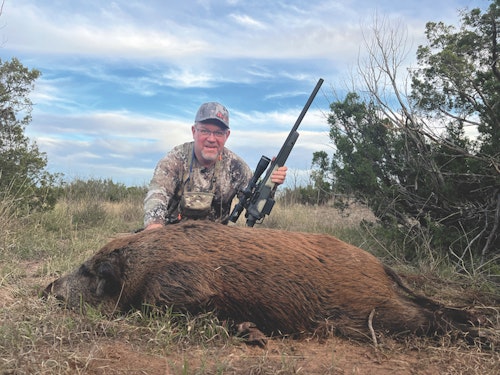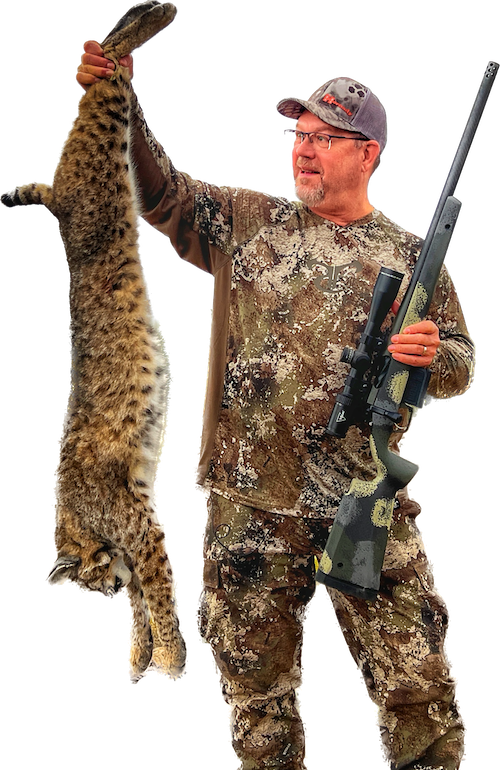While we were headed for the deer blind on the first afternoon of my hunt, my Lowrance Ranch outfitter and guide, Colton Beam, showed me a few photos of our target buck — a beast with 10 tall evenly matched tines. And as we drove toward our hunt area, we saw several coyotes scurry for cover. My mind immediately started to wander.
The blind was perfectly situated on a hillside overlooking a large open area. It blended well into the brushy Texas terrain and was downwind of the main travel corridors. Any approaching deer would have to climb the tall hill behind us to catch our scent. The blind chairs were comfortable, and I had the shooting sticks strategically placed so I could shoot in most directions.
We weren’t in the blind 30 minutes when a whitetail sneaked in from our left — a young buck that was already in bow range by the time we spotted him, passing by without sensing we were there. Soon a second buck showed up and raked his antlers in the trees adjacent to a brush pile along the access road. We were enjoying the sights and sounds of the morning when the deer started to get nervous, and I sensed a big buck would emerge from the thorny bushes at any moment. To my surprise, a giant wild boar edged out of the cover and started feeding along the road. This black tusker was no ordinary hog and would certainly tip the scale at over 300 pounds. I had trouble keeping my finger off the trigger but knew that if I shot the hog it could mess up the deer hunt, so I held back. The pig fed for more than half an hour before turning and melting back into the cover.
With 20 minutes of legal shooting light left, a buck walked into the clearing. And like a chameleon blending in with the arid Texas landscape, he was 30 yards into the opening before we spotted him in the fading light. His antlers were tall, and it took only a second to confirm he was our target buck. I settled the crosshairs of the Trijicon Credo riflescope behind the buck’s front shoulder and when he stopped to feed, I slowly tightened up on the trigger. The bullet found its mark, and the deer dropped where it was standing. My deer hunt might have been short-lived, but the good news was that I had four more days to hunt, and the ranch was literally crawling with coyotes, bobcats and hogs.
Targeting big bucks seldom leaves extra time to hunt other critters. And there isn’t always an open season or opportunity to hunt predators once a deer tag is punched. But this hunt was the perfect storm. I had tagged out early on an excellent Texas whitetail and knew the ranch was overrun with predators and wild hogs. I had to pinch myself to make sure it was real.
A Squealing Good Time
Colton and I settled back into the hunting blind the next day, hoping the black boar we’d spotted the day before would reappear. There were still several hours of daylight left, and we didn’t expect to see much action until the sun started to drop toward the horizon. The afternoon sit was laid back and relaxed — until I looked down the road and saw a sounder of pigs headed in our direction! No big black hog, but plenty of other colors and some medium-sized black oinkers.
The hogs trotted into the clearing and slowed down to start grazing. The biggest in the bunch, a giant bronze hog, had my attention. We let the hogs feed as far out as possible before waiting for the target pig to turn broadside. I took a deep breath and knew it would be fast action after the first shot. Boom! The bronze hog took a killing shot, and the rest of the pigs scattered like they were blasted out of a shotgun.
I anchored my crosshairs on the head of another big pig, and when I touched off the shot, I saw the bullet miss the mark, passing within an inch of the hog’s nose. I chambered another cartridge as most of the pigs disappeared into the brush but quickly put the crosshairs on the neck of a black hog that hadn’t taken the most direct escape route. The 143-grain Hornady ELD-X bullet struck right where I was aiming, sending the hog cartwheeling to a stop. I was happy with a double and knew that it was unlikely we would see hide nor hair of the big black boar after all the commotion. We called for a pickup, loaded the hogs and headed back to camp.

Lone Star Coyote Caper
The following day, we set up on the edge of a winter wheat field with an e-caller placed about 100 yards out. It took about 10 minutes for the first coyote to show up, but as it edged along the field, something spooked it, and it ran back into cover. We changed the sounds on the caller, and the old dog couldn’t resist a closer look and came running into the open. I used a sharp bark to stop the coyote in its tracks and the report of my rifle set the score in favor of the hunters.
We drove several miles into a pasture with deep-cut creek-bottoms and rocky outcrops — rough land ideal for predator calling. I’ve always had a soft spot for calling bobcats and had discussed it with my guide, Josh Leesman, that morning. This guy is a hunter who loves competitions that keep him well-honed at all things predator hunting.
We set up high on a rocky outcrop overlooking a grassy flat surrounded by brush. With the sounds of a squealing rabbit echoing down the creek, it took only seconds before we spotted several ’yotes running up and into the brush about 300 yards away. Then it was a waiting game where we needed to spot them before they spotted us or got downwind. Unfortunately, the first dog ran through the brush and caught our wind, sending it high tailing for safer ground. However, a minute later a white-chested coyote popped up in the brush about 75 yards away, looking toward the caller. I centered the aiming dot of my riflescope on its chest and squeezed the trigger. It collapsed in its tracks, leaving a puff of hair drifting silently in the wind.
Josh immediately changed the call, and two minutes later we had three coyotes sneak in right under our noses. They came from around the hill we were sitting on and broke out about 30 yards below us. It was a mad scramble as both Leesman and I fired several shots, with one more coyote taking a hit.
We tried a few more setups before returning to the ranch for lunch. We had seen an incredible number of coyotes that reacted as though they had never been hunted. It was a utopia for predator hunting, and we quickly made plans for the afternoon hunt.
The wind had picked up and that made calling a challenge, but we picked our spots strategically and worked those where our odds for success were the highest. There was hog sign everywhere, as well as coyote and bobcat tracks. As the sun was setting, we had a big coyote charge the caller and practically trip over it before making a hard turn to get out of Dodge. I tracked it in my scope and slowly squeezed the trigger. At the rifle report, the coyote disappeared into the grass, and the resounding whack of the 6.5 Creedmoor bullet confirmed a direct hit.
The day’s events weren’t over, as we used a red light to spotlight the area after dark as we continued to call. The wind had us snookered, so we opted to work our way back to camp and look for more critters, and we were not disappointed. We probably saw more than 20 hogs, most which were huge. It was an exciting day and early night with excellent results.
Targeting Bobcats
Tyler Bream stepped up to take me out for bobcats the next morning, and his homegrown expertise was welcomed. Our first setup was adjacent to a wetland with plenty of waterfowl. Our next set was along a right-of-way where Tyler had seen a bobcat crossing the road. Neither stand produced. Unfortunately, cats do not always come easy, and we headed to an area that dropped into a brushy ravine and creek-bottom.
We sat in the brush and set the caller out in the wavering grass about 60 yards away. A few minutes had passed when I hissed, “Cat,” and tipped my rifle in the direction of the long grass and steadied my crosshairs on the cat’s chest. At the rifle’s report, the cat collapsed in its tracks.
I was ecstatic. The cat was a huge male with incredible coloring and was the icing on the cake after success on deer, hogs, coyotes — with more encounters in a few days than most hunters experience in a month of calling. I hope to return to hunt deer there next year, and you can bet I’ll be bringing my predator calls.







